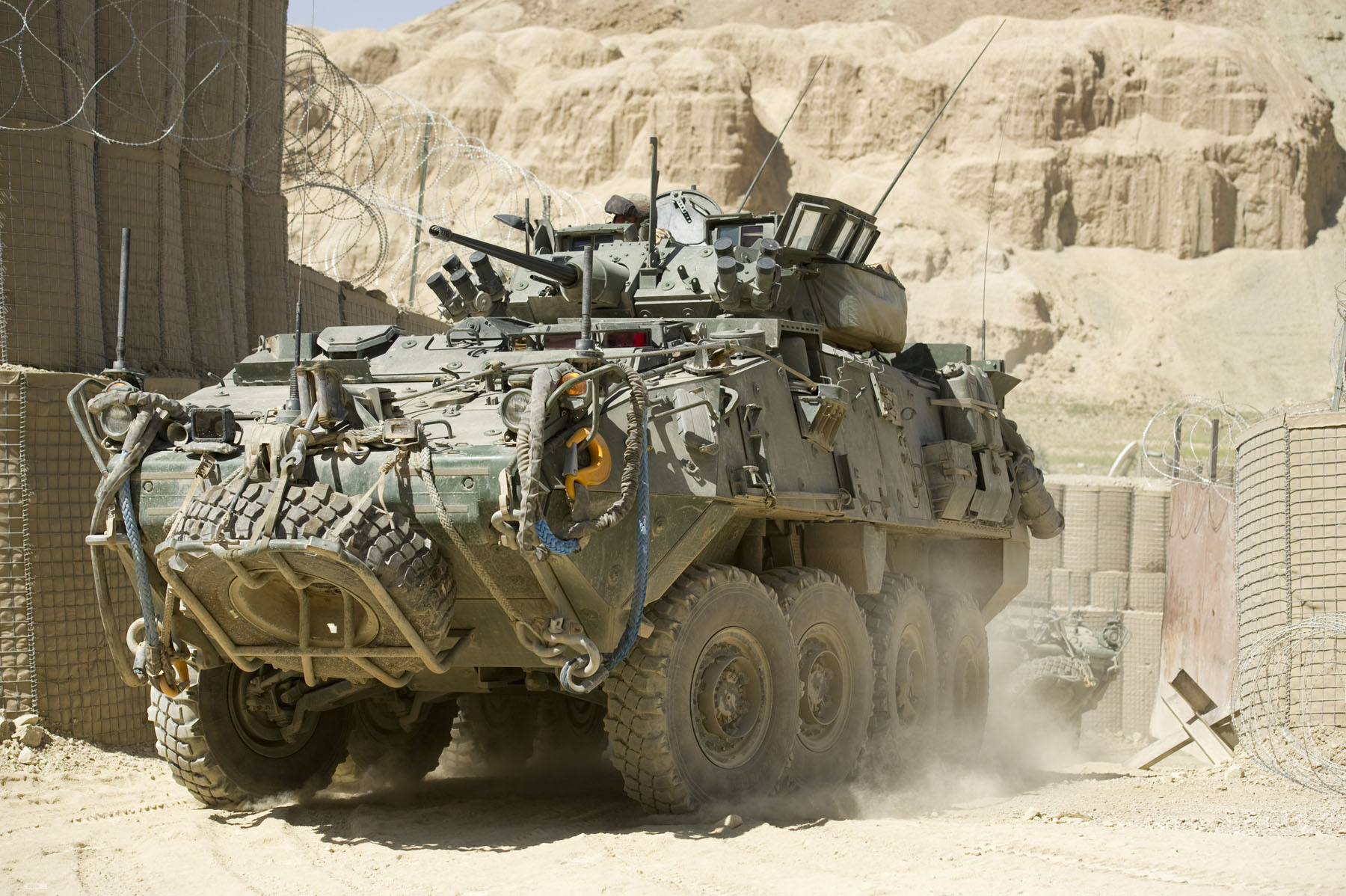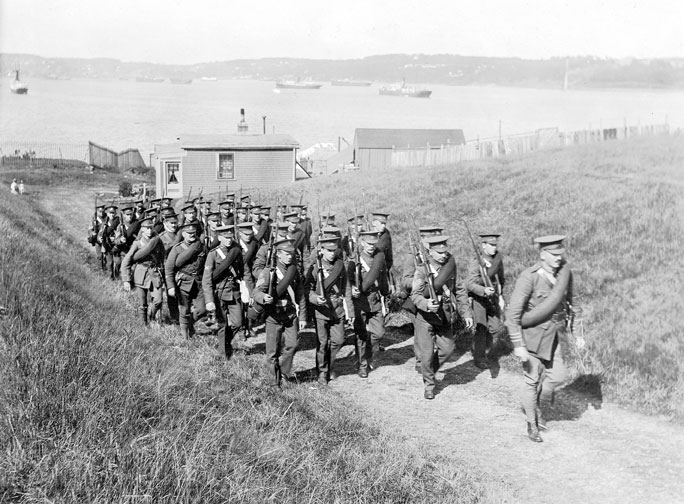|
12e Régiment Blindé Du Canada
The 12e Régiment blindé du Canada (a translation of its former name, the "12th Canadian Armoured Regiment") is a Canadian Army armoured regiment based in CFB Valcartier, on the outskirts of Quebec City. The regiment has both a Regular Force and a Primary Reserve unit. The 12e Régiment blindé du Canada's abbreviation is 12e RBC. In the Regular Force regiment, all three Squadrons are based on the LAV family of vehicles and are designated as light armoured cavalry squadrons. Each squadron is currently organized into troops of four vehicles each. C Squadron, 12e RBC is located at CFB Gagetown as part of C Squadron, the Royal Canadian Dragoons. Lineage 12e Régiment blindé du Canada *Originated 24 March 1871 in Trois-Rivières, Quebec as the Three Rivers Provisional Battalion of Infantry *Redesignated 4 June 1880 as the 86th "Three Rivers" Battalion of Infantry *Redesignated 8 May 1900 as the 86th Three Rivers Regiment *Redesignated 29 March 1920 as The Three Rivers Regiment * ... [...More Info...] [...Related Items...] OR: [Wikipedia] [Google] [Baidu] |
Armoured Warfare
Armoured warfare or armored warfare (mechanized forces, armoured forces or armored forces) (American English; American and British English spelling differences#-our, -or, see spelling differences), is the use of armoured fighting vehicle, armored fighting vehicles in modern warfare. It is a major component of modern Military science, methods of war. The premise of armoured warfare rests on the ability of troops to penetrate conventional Defense (military), defensive lines through use of Maneuver warfare, manoeuvre by armoured units. Much of the application of armoured warfare depends on the use of tanks and related vehicles used by other supporting arms such as infantry fighting vehicles, self-propelled artillery, and other combat vehicles, as well as mounted combat engineers and other support units. The doctrine of armoured warfare was developed to break the static nature of World War I trench warfare on the Western Front (World War I), Western Front, and return to the 19th ce ... [...More Info...] [...Related Items...] OR: [Wikipedia] [Google] [Baidu] |
LAV III
The LAV III, originally named the Kodiak by the Canadian Army, is the third generation of the LAV (Canada), Light Armoured Vehicle (LAV) family of armored personnel carriers built by General Dynamics Land Systems – Canada (GDLS-C), a London, Ontario, based subsidiary of General Dynamics Land Systems, General Dynamics. It first entered service in 1999, succeeding the LAV II. It is the primary mechanized infantry vehicle of both the Canadian Army and the New Zealand Army. It also forms the basis of the Stryker vehicle used by the U.S. Army and other operators. The Canadian Army is upgrading its LAV IIIs to the LAV 6 standard. Development By July 1991, the Canadian Army, Canadian Armed Forces had identified the need to replace their aging fleet of 1960s and 1970s era armoured personnel carriers. As a result, $2.8 billion was earmarked for the TH-495, Multi-Role Combat Vehicle (MRCV) project by the sitting Progressive Conservative Party of Canada, Conservative government. The manda ... [...More Info...] [...Related Items...] OR: [Wikipedia] [Google] [Baidu] |
Rivière-du-Loup-en-Haut
Louiseville is a town in the Mauricie region of the province of Quebec in Canada. It is located near the mouth of the 'Rivière-du-Loup', on the north shore of Lac Saint-Pierre. Louiseville is twinned with Soissons in France and Cerfontaine in Belgium. History The area was originally part of the la Seignorie Rivière-du-Loup. This seignory was formed in 1665 by Intendant Jean Talon and granted in 1672 to Charles Dugey Rozoy-de-Mannereuil, officer in the Carignan Regiment. The seignory was thereafter also known as Rivière-Mannereuil for some time. In 1714, a mission was formed by the Récollets who dedicated it to the patronage of Anthony of Padua. In 1722, the Ursulines owned the seignory and attempted to change the name to Saint-Antoine-de-la-Rivière-Saint-Jean but the settlement became known as Rivière-du-Loup or Rivière-du-Loup-en-Haut after the seignory or local river. In 1816, its post office opened. In 1845, the Parish Municipality of Rivière-du-Loup-en-Haut was f ... [...More Info...] [...Related Items...] OR: [Wikipedia] [Google] [Baidu] |
Montreal
Montreal ( ; officially Montréal, ) is the List of the largest municipalities in Canada by population, second-most populous city in Canada and List of towns in Quebec, most populous city in the Provinces and territories of Canada, Canadian province of Quebec. Founded in 1642 as ''Fort Ville-Marie, Ville-Marie'', or "City of Mary", it is named after Mount Royal, the triple-peaked hill around which the early city of Ville-Marie is built. The city is centred on the Island of Montreal, which obtained its name from the same origin as the city, and a few much smaller peripheral islands, the largest of which is Île Bizard. The city is east of the national capital Ottawa, and southwest of the provincial capital, Quebec City. As of 2021, the city had a population of 1,762,949, and a Census Metropolitan Area#Census metropolitan areas, metropolitan population of 4,291,732, making it the List of the largest municipalities in Canada by population, second-largest city, and List of cen ... [...More Info...] [...Related Items...] OR: [Wikipedia] [Google] [Baidu] |
Trois-Rivières
Trois-Rivières (, – 'Three Rivers') is a city in the Mauricie administrative region of Quebec, Canada, at the confluence of the Saint-Maurice River, Saint-Maurice and Saint Lawrence River, Saint Lawrence rivers, on the north shore of the Saint Lawrence River across from the city of Bécancour, Quebec, Bécancour. It is part of the densely populated Quebec City–Windsor Corridor and is approximately halfway between Montreal and Quebec City. Trois-Rivières is the economic and cultural hub of the Mauricie region. The settlement was founded by French colonists on July 4, 1634, as the second permanent settlement in New France, after Quebec City in 1608. The city's name, which is French for 'three rivers', is named for the fact the Saint-Maurice River has three mouths at the Saint Lawrence River; it is divided by two islands in the river. Historically, in English this city was once known as Three Rivers. Since the late 20th century, when there has been more recognition of Quebec a ... [...More Info...] [...Related Items...] OR: [Wikipedia] [Google] [Baidu] |
259th Battalion, Canadian Rifles, CEF (Siberia)
The 259th Battalion, Canadian Rifles, CEF (Siberia), was an infantry battalion of the Canadian Expeditionary Force Siberia during the Great War. History The 259th Battalion was authorized on 1 November 1918 and embarked for Russia on 22 and 26 December 1918. The unit disembarked at Vladivostok on 12 and 15 January 1919 where it served with the 16th Infantry Brigade as part of the Allied Forces in eastern Russia until 19 May 1919. The battalion disbanded on 6 November 1920.Canadian Forces Publication A-DH-267-003 Insignia and Lineages of the Canadian Forces. Volume 3: Combat Arms Regiments. The 259th Battalion recruited in London and Kingston, Ontario, and Montreal and Quebec City, Quebec and was mobilized at Victoria, British Columbia.Meek, John F. ''Over the Top! The Canadian Infantry in the First World War.'' Orangeville, Ont.: The Author, 1971. The 259th Battalion was commanded by Lt.-Col. A.E. Swift. Perpetuations Since 25 June 1998, the 259th Battalion, Canadian Rifles ... [...More Info...] [...Related Items...] OR: [Wikipedia] [Google] [Baidu] |
178th Battalion (Canadien-Français), CEF
The 178th (Canadien-Français) Battalion, CEF was a unit in the Canadian Expeditionary Force during the First World War. Based in Victoriaville, Quebec, the unit began recruiting during the winter of 1915/16 in Military Districts 4 and 5, and in eastern Ontario. The battalion absorbed the 233rd Battalion (Canadiens-Français du Nord-Ouest), CEF, in March 1917, and sailed to England later that same month. Upon arrival, the 178th Battalion was absorbed into the 10th Reserve Battalion on March 16, 1917. The 178th (Canadien-Français) Battalion had one officer commanding: Lieutenant-Colonel René-Arthur de la Bruère Girouard. The battalion badge is a beaver ''couchant'' on plinth inscribed above the numeral 178, below an arch inscribed supporting the Tudor crown The Tudor Crown, also known as Henry VIII's Crown, was the imperial and state crown of English monarchs from around the time of Henry VIII until it was destroyed during the Civil War in 1649. It was described by th ... [...More Info...] [...Related Items...] OR: [Wikipedia] [Google] [Baidu] |
Royal Canadian Artillery
, colors = The guns of the RCA themselves , colors_label = Colours , march = * Slow march: "Royal Artillery Slow March" * Quick march (dismounted parades): "British Grenadiers/The Voice of the Guns" * Trot past: "Keel Row" * Gallop past (horse artillery only): "Bonnie Dundee" , mascot = , anniversaries = * 1855: Militia Act of 1855 passed by the Parliament of the Province of Canada and creation the first truly Canadian army units * 27 November 1856: first Canadian Artillery unit formed (''Battalion of Montreal Artillery'') * 10 August 1883: ''Regiment of Canadian Artillery'' of the Permanent Active Militia authorized to be formed , equipment = * M101 howitzer#Variants, 105 mm Howitzer, C3 * GIAT LG1, 105 mm Howitzer, LG1 Mk II * M777 howitzer#Canada, 155 mm Howitzer M777C1 , equipment_label = Current weapon systems , battle_honours ... [...More Info...] [...Related Items...] OR: [Wikipedia] [Google] [Baidu] |
Canadian Expeditionary Force
The Canadian Expeditionary Force (CEF) was the expeditionary field force of Canada during the First World War. It was formed following Britain’s declaration of war on Germany on 15 August 1914, with an initial strength of one infantry division. The division subsequently fought at Ypres on the Western Front, with a newly raised second division reinforcing the committed units to form the Canadian Corps. The CEF and corps was eventually expanded to four infantry divisions, which were all committed to the fighting in France and Belgium along the Western Front. A fifth division was partially raised in 1917, but was broken up in 1918 and used as reinforcements following heavy casualties. Personnel Recruitment The Canadian Expeditionary Force was mostly volunteers; a bill allowing conscription was passed in August, 1917, but not enforced until call-ups began in January 1918 (''see'' Conscription Crisis of 1917). In all, 24,132 conscripts had been sent to France to take part ... [...More Info...] [...Related Items...] OR: [Wikipedia] [Google] [Baidu] |
Canadian Active Service Force
Canadians (french: Canadiens) are people identified with the country of Canada. This connection may be residential, legal, historical or cultural. For most Canadians, many (or all) of these connections exist and are collectively the source of their being ''Canadian''. Canada is a multilingual and multicultural society home to people of groups of many different ethnic, religious, and national origins, with the majority of the population made up of Old World immigrants and their descendants. Following the initial period of French and then the much larger British colonization, different waves (or peaks) of immigration and settlement of non-indigenous peoples took place over the course of nearly two centuries and continue today. Elements of Indigenous, French, British, and more recent immigrant customs, languages, and religions have combined to form the culture of Canada, and thus a Canadian identity. Canada has also been strongly influenced by its linguistic, geographic, and ec ... [...More Info...] [...Related Items...] OR: [Wikipedia] [Google] [Baidu] |

.jpg)




